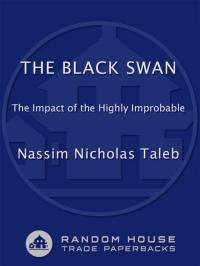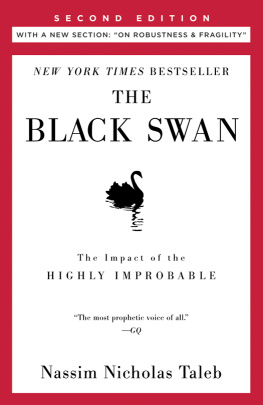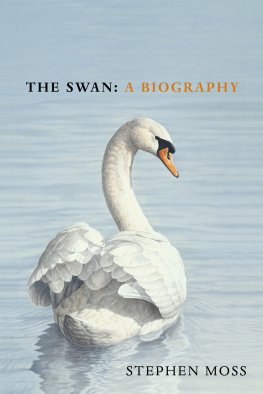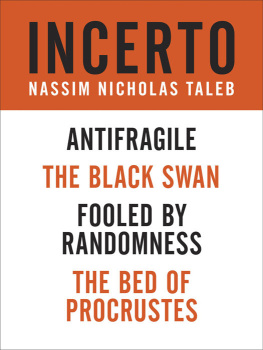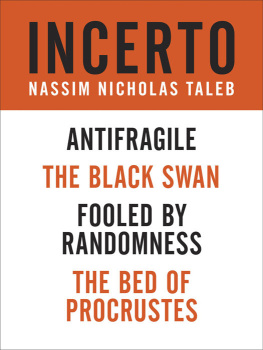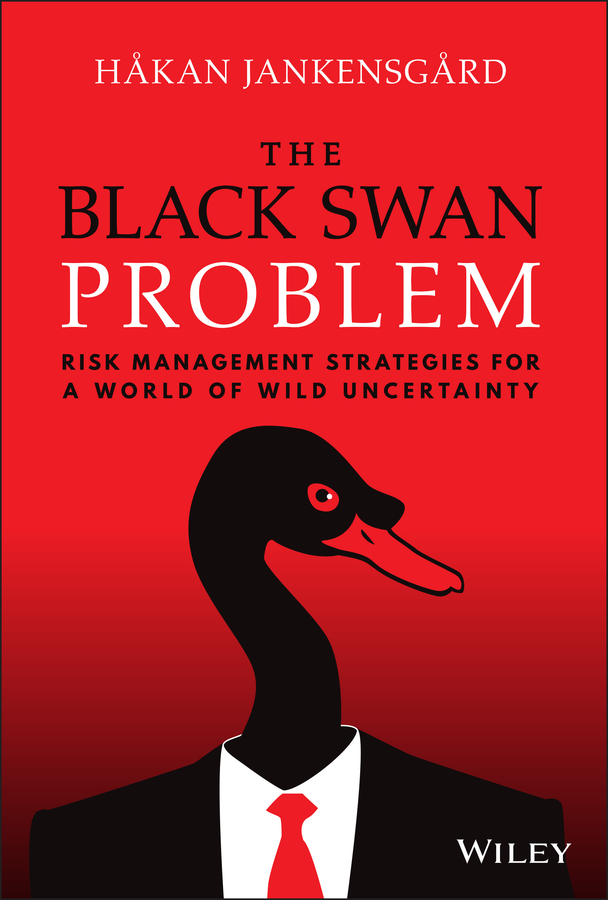
Table of Contents
List of Tables
- Chapter 1
- Chapter 4
- Chapter 7
List of Illustrations
- Chapter 2
- Chapter 3
- Chapter 4
- Chapter 5
- Chapter 6
- Chapter 7
Guide
Pages
FOUNDED IN 1807, JOHN Wiley & Sons is the oldest independent publishing company in the United States. With offices in North America, Europe, Asia, and Australia, Wiley is globally committed to developing and marketing print and electronic products and services for our customers professional and personal knowledge and understanding.
The Wiley Corporate F&A series provides information, tools, and insights to corporate professionals responsible for issues affecting the profitability of their company, from accounting and finance to internal controls and performance management.
The Black Swan Problem
Risk Management Strategies for a World of Wild Uncertainty
HKAN JANKENSGRD

This edition first published 2022
Copyright 2022 by John Wiley & Sons, Ltd.
Registered office
John Wiley & Sons Ltd, The Atrium, Southern Gate, Chichester, West Sussex, PO19 8SQ, United Kingdom
For details of our global editorial offices, for customer services and for information about how to apply for permission to reuse the copyright material in this book please see our website at www.wiley.com.
All rights reserved. No part of this publication may be reproduced, stored in a retrieval system, or transmitted, in any form or by any means, electronic, mechanical, photocopying, recording or otherwise, except as permitted by the UK Copyright, Designs and Patents Act 1988, without the prior permission of the publisher.
Wiley publishes in a variety of print and electronic formats and by printondemand. Some material included with standard print versions of this book may not be included in ebooks or in printondemand. If this book refers to media such as a CD or DVD that is not included in the version you purchased, you may download this material at http://booksupport.wiley.com. For more information about Wiley products, visit www.wiley.com.
Designations used by companies to distinguish their products are often claimed as trademarks. All brand names and product names used in this book are trade names, service marks, trademarks or registered trademarks of their respective owners. The publisher is not associated with any product or vendor mentioned in this book.
Limit of Liability/Disclaimer of Warranty: While the publisher and author have used their best efforts in preparing this book, they make no representations or warranties with respect to the accuracy or completeness of the contents of this book and specifically disclaim any implied warranties of merchantability or fitness for a particular purpose. It is sold on the understanding that the publisher is not engaged in rendering professional services and neither the publisher nor the author shall be liable for damages arising here from. If professional advice or other expert assistance is required, the services of a competent professional should be sought.
Library of Congress CataloginginPublication Data:
Names: Jankensgrd, Hkan, author.
Title: The black swan problem : risk management strategies for a world of wild uncertainty / Hkan Jankensgrd.
Description: First edition. | Chichester, United Kingdom : Wiley, 2022. | Includes index.
Identifiers: LCCN 2021062804 (print) | LCCN 2021062805 (ebook) | ISBN 9781119868149 (cloth) | ISBN 9781119868156 (adobe pdf) | ISBN 9781119868163 (epub)
Subjects: LCSH: Risk management. | Organizational effectiveness.
Classification: LCC HD61 .J355 2022 (print) | LCC HD61 (ebook) | DDC 658.15/5dc23/eng/20220112
LC record available at https://lccn.loc.gov/2021062804
LC ebook record available at https://lccn.loc.gov/2021062805
Cover Design and Image: Wiley
Illustration inspired by: rainman_in_sun/Getty Images
My dear children, Wilma and August, I wrote this book for you.
Our world is dominated by the extreme, the unknown, and the very improbable and all the while we spend our time engaged in small talk, focusing on the known and the repeated.
Nicholas Nassim Taleb
Prologue
MY FIRST INTRODUCTION TO Black Swan thinking did not come from the famous book by Nicholas Nassim Taleb published in 2007. It came well before that, courtesy of my instructor as I was training to get a driver's licence for motorcycles. We had stopped at an intersection, when the arrow turned green and I just rode off onto the highway in a nice left turn. The instructor immediately told me to pull over. Once we did, he started lambasting me for having made the turn without looking even once to my right. He was visibly upset, or at least played his part well. But the arrow was green, I meekly responded, so the others must stop. In my worldview, that was how it worked. My experience, while not exactly extensive, supported that notion. In fact, nothing had ever suggested otherwise. Do you think, he yelled, that you can trust others to do what they are supposed to do? Never assume that! The penny dropped. By operating on a very nave assumption about how the world worked, based on a handful of observations, I had managed to make myself a sucker. I was setting myself up, unnecessarily, for a highly improbable major calamity.
The deeper meaning of the Black Swan idea is not to be paranoid and develop trust issues. Rather it is to resist the temptation to base our course of action on pristine ideas and models of how the world ought to be. Especially dangerous is our inclination to form expectations of a benign world based on recent observations that all seem to indicate stability. Taleb's choice of metaphor the Black Swan was meant to convey precisely this problem of induction. It had always been taken for granted that all swans are white, an assumption supported by millions of observations across centuries. Imagine the surprise when the black variety was sighted in Australia subsequent to the discovery of that continent. All it took was one single observation to turn completely on its head what people had internalized as selfevident and true for hundreds of years. Likewise, a single rogue or inattentive driver can invalidate, in an instant, hundreds of observations of other drivers yielding when the arrow is green. A recurring theme in Taleb's Black Swan framework is that we fail to make provisions for such outliers because they are outside our mental models and decisionsupport tools.
So what is this famed and metaphorical creature more precisely? A Black Swan, according to Taleb, has three attributes. Before it occurs, it is considered extremely unlikely, to the extent we grant it for possible at all. When it occurs, its consequences are massive. After it has occurred, it makes perfect sense to us that something like that could happen. The last attribute is due to our brains being awesome explanation machines that crave coherence. Dots will be ambitiously connected until coherence is established. The world inhabited by these Black Swans is characterized by uncertainty that is wild rather than benign, meaning that there is always a potential for great dislocations and nonlinearities. Even when we manage to bring our focus to the tail end of the distribution, we frequently find that it is in flux, with events greatly surpassing anything we have seen or heard before.
Next page

